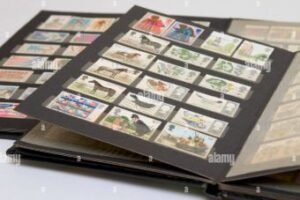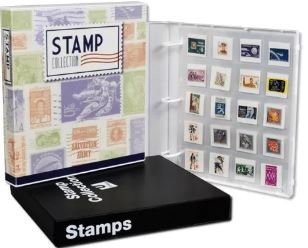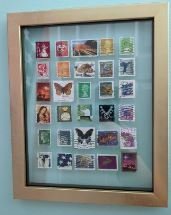Organizing a stamp collection can seem like a daunting task, especially for beginners or those with a growing collection. However, with the right approach, how to organize stamp collections can become an enjoyable and rewarding process. A well-organized collection not only makes it easier to manage and appreciate your stamps, but it also helps maintain their value over time. In this article, we’ll explore the essential steps to properly organize your collection, how to avoid common mistakes, and how to ensure that your collection remains in top condition.

Why Organize Your Stamp Collection?
Before diving into how to organize stamp collections, it’s important to understand why organization matters. A well-organized collection allows you to:
- Easily access and display stamps: When your collection is sorted, it becomes easier to locate specific stamps, whether for display purposes or when seeking to complete your set.
- Preserve the condition of your stamps: Proper organization helps prevent damage, such as bending, fading, or exposure to moisture.
- Increase the value of your collection: An organized collection is not only more valuable to you but can also command higher prices if you ever decide to sell or trade stamps.
Step 1: Assess Your Collection
The first step in how to organize stamp collections is to assess what you have. Start by laying out all of your stamps and sorting them by type, origin, or theme. You might have stamps from different countries, eras, or thematic collections (such as animals, historical events, or famous figures). Assessing your collection will give you a clearer idea of how to approach organizing it and help you identify any gaps in your collection.
When you begin, ask yourself these questions:
- What types of stamps do I own? Are they from specific countries, regions, or collections?
- How much space do I have? Are you organizing a small or large collection? This will help you determine the most efficient storage and organizational methods.
- What condition are the stamps in? Some stamps may require extra care, such as being stored in protective sleeves or albums.
Step 2: Categorize and Sort Your Stamps
Now that you have assessed your collection, the next step in how to organize stamp collections is categorizing and sorting your stamps. The best way to organize your stamps depends on your personal preferences and the size of your collection. Here are a few methods to consider:

- By Country: Many collectors prefer to organize their stamps by country. This is especially useful if your collection includes stamps from various parts of the world. You can group stamps by continent or region and then sub-categorize them by individual countries.
- By Theme: If you collect stamps based on specific themes, such as birds, trains, or sports, consider organizing them into thematic categories. This method allows for easier access when adding new stamps to your collection.
- By Date/Period: Another way to organize your collection is by the date or period when the stamps were issued. You can sort them into categories like “pre-1900,” “early 20th century,” and so on. This is particularly useful for those collecting vintage or historical stamps.
- By Condition: If your collection includes stamps in varying conditions, you may choose to organize them by their quality. This way, you can easily differentiate between mint, lightly used, and heavily damaged stamps.
No matter the method you choose, how to organize stamp collections requires consistency. Stick to one organizational scheme to avoid confusion later.
Step 3: Invest in Proper Storage Materials
Once you’ve categorized and sorted your stamps, the next step in how to organize stamp collections is investing in the right storage materials. Proper storage is crucial to maintaining the condition and value of your stamps. Some essential storage options include:
- Stamp Albums: A classic choice for storing stamps, stamp albums come in various sizes and formats. Look for albums with acid-free pages to protect your stamps from deterioration.
- Stock Books: Stock books are ideal for organizing stamps in a way that allows for easy flipping through. They typically have transparent pockets where you can place your stamps.
- Stock Pages: These pages are used in binders and provide clear pockets for your stamps. They allow you to organize your collection efficiently, and you can easily add or remove pages as your collection grows.
- Mounts and Sleeves: For rare or valuable stamps, using mounts or individual plastic sleeves can protect the stamps from handling and environmental damage.
By using these protective materials, you can ensure that your collection remains in excellent condition as you continue how to organize stamp collections.

Step 4: Label and Record Your Collection
As you organize your stamps, consider creating a record or inventory of your collection. This will be useful for tracking the value, condition, and history of your stamps. You can do this manually or use software designed for stamp collecting.
- Manual Inventory: Write down important details for each stamp, such as the country of origin, the year of issue, and any distinguishing features (such as rare varieties, misprints, or printing errors).
- Digital Inventory: Many collectors today prefer using digital tools to catalog their collections. There are apps and software that allow you to store information, take photos of each stamp, and even value your collection.
Additionally, labeling your stamps can help in identifying and organizing them as you continue with how to organize stamp collections. Use a gentle pen to mark your storage pages or albums with brief information about the contents of each section.
Step 5: Regular Maintenance and Updates
One of the most important aspects of how to organize stamp collections is regular maintenance. As your collection grows, you’ll need to periodically update it and make adjustments to your storage and categorization methods. Ensure that new stamps are added correctly and that older stamps remain in excellent condition.
- Reevaluate Storage: If your collection outgrows its current storage system, consider investing in a larger album, more stock pages, or additional protective materials.
- Check for Deterioration: Over time, stamps may deteriorate if not properly stored. Make sure they are free from moisture, sunlight, and environmental factors that could cause fading or discoloration.
- Reorganize When Necessary: If your collection has grown in unexpected ways, consider reorganizing to accommodate new stamps. You may need to move stamps into new categories or albums.

Stamp collecting, also known as philately, has long been a popular hobby for enthusiasts around the world. However, beyond the simple pleasure of collecting, many people view stamps as a potential investment opportunity.
Conclusion
Learning how to organize stamp collections is a crucial step in making the most of your hobby. Whether you’re a beginner or an experienced collector, the key to a successful collection is consistency and organization. By assessing your collection, categorizing stamps, investing in proper storage materials, and keeping track of your stamps, you can create a well-organized and valuable collection that will bring you years of enjoyment. So, take the time to properly organize your stamps and avoid common mistakes – it will pay off in the long run!




